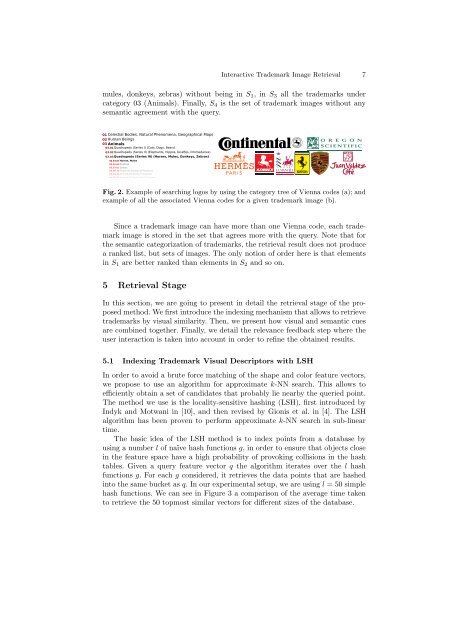Interactive Trademark Image Retrieval by Fusing Semantic and ...
Interactive Trademark Image Retrieval by Fusing Semantic and ...
Interactive Trademark Image Retrieval by Fusing Semantic and ...
Create successful ePaper yourself
Turn your PDF publications into a flip-book with our unique Google optimized e-Paper software.
<strong>Interactive</strong> <strong>Trademark</strong> <strong>Image</strong> <strong>Retrieval</strong> 7<br />
mules, donkeys, zebras) without being in S 1 , in S 3 all the trademarks under<br />
category 03 (Animals). Finally, S 4 is the set of trademark images without any<br />
semantic agreement with the query.<br />
01 Celestial Bodies, Natural Phenomena, Geographical Maps<br />
02 Human Beings<br />
03 Animals<br />
03.01 Quadrupeds (Series I) (Cats, Dogs, Bears)<br />
03.02Quadrupeds (Series II) (Elephants, Hippos, Giraffes, Dromedaries)<br />
03.03 Quadrupeds (Series III) (Horses, Mules, Donkeys, Zebras)<br />
03.03.01 Horses, Mules<br />
03.03.02 Donkeys<br />
03.03.03 Zebras<br />
03.03.15 Heads Of Animals Of Series III<br />
03.03.24 Animals Of Series III Stylized<br />
03.03.25 Animals Of Series III In Costume<br />
Fig. 2. Example of searching logos <strong>by</strong> using the category tree of Vienna codes (a); <strong>and</strong><br />
example of all the associated Vienna codes for a given trademark image (b).<br />
Since a trademark image can have more than one Vienna code, each trademark<br />
image is stored in the set that agrees more with the query. Note that for<br />
the semantic categorization of trademarks, the retrieval result does not produce<br />
a ranked list, but sets of images. The only notion of order here is that elements<br />
in S 1 are better ranked than elements in S 2 <strong>and</strong> so on.<br />
5 <strong>Retrieval</strong> Stage<br />
In this section, we are going to present in detail the retrieval stage of the proposed<br />
method. We first introduce the indexing mechanism that allows to retrieve<br />
trademarks <strong>by</strong> visual similarity. Then, we present how visual <strong>and</strong> semantic cues<br />
are combined together. Finally, we detail the relevance feedback step where the<br />
user interaction is taken into account in order to refine the obtained results.<br />
5.1 Indexing <strong>Trademark</strong> Visual Descriptors with LSH<br />
In order to avoid a brute force matching of the shape <strong>and</strong> color feature vectors,<br />
we propose to use an algorithm for approximate k-NN search. This allows to<br />
efficiently obtain a set of c<strong>and</strong>idates that probably lie near<strong>by</strong> the queried point.<br />
The method we use is the locality-sensitive hashing (LSH), first introduced <strong>by</strong><br />
Indyk <strong>and</strong> Motwani in [10], <strong>and</strong> then revised <strong>by</strong> Gionis et al. in [4]. The LSH<br />
algorithm has been proven to perform approximate k-NN search in sub-linear<br />
time.<br />
The basic idea of the LSH method is to index points from a database <strong>by</strong><br />
using a number l of naïve hash functions g, in order to ensure that objects close<br />
in the feature space have a high probability of provoking collisions in the hash<br />
tables. Given a query feature vector q the algorithm iterates over the l hash<br />
functions g. For each g considered, it retrieves the data points that are hashed<br />
into the same bucket as q. In our experimental setup, we are using l = 50 simple<br />
hash functions. We can see in Figure 3 a comparison of the average time taken<br />
to retrieve the 50 topmost similar vectors for different sizes of the database.


